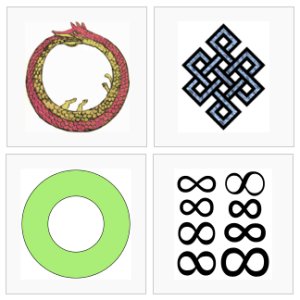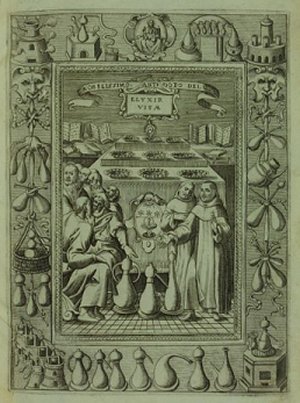Eternity and Immortality

Eternity means endless or infinite time, a duration without beginning or end. It has much in common with the idea of infinity (an abstract concept describing something without any limit), and with immortality (eternal or unending life or youth).
Eternity
In philosophy, there are two main views of eternity:
- Eternity as a timeless realm, without succession, duration or sequence. In this view, there is no “before” or “after”, and the past, present and future as we think of them all exist together in an eternal “Now”. This was the view of the early Christian theologian St. Augustine and, before him, of Plato and the Neo-Platonists.
- Eternity as never-ending time, without beginning or end, but nevertheless time as we normally think of it, with duration and succession from the past towards the future. Such a view was held by Aristotle, as well as many early Christians (before St. Augustine), and even the Early Modern philosopher John Locke.
Eternity is a prominent feature of some early views of the universe. Many ancient civilizations, from Hindus and Buddhists to the ancient Greek Orphics and Pythagoreans, believed in a cyclic view of time, the “wheel of time” or Kalachakra, in which there are repeating ages over the infinite life of the universe. Such a belief seem to presuppose an overall linear ordering, in some sort of “hyper-time”, of all the cycles. Eternity is an important concept in many different religions, and indeed it is quite difficult to find opinions on eternity that do NOT spring from, or are at least influenced by, religion in some way.
The great Greek philosopher Aristotle saw the cosmos as finite in spatial extent but eternal in time, stretching back to the infinite past and forward into the infinite future. Aristotle argued that, if time had a beginning, then one could refer to a time before that beginning (because something must precede a beginning), which is contradictory to the premise. Also, to Aristotle, time was a series of beginnings and ends, or moments, with each moment ending the one before it. Therefore, any “first moment” or beginning to time must have ended a moment before it, which is also contradictory. From these contradictions, Aristotle concluded that time must be eternal.
In support of this view, the Neo-Platonist philosopher Proclus in the 5th Century CE presented no less than eighteen proofs for the eternity of the world, largely resting on the divinity of its Creator. Less than a century later, the early Christian theologist John Philoponus systematically argued against every one of Proclus’ propositions.
In the Middle Ages, scholastic Christian, Muslim and Jewish philosophers started to argue against the widely-held early view that time and the universe as a whole is eternal, having realized that it militates against the idea of God as the all-powerful Creator of the universe, an important plank of thought in the Abrahamic religions. This became a particular focus of dispute in the 13th Century, when many of the works of Aristotle were rediscovered in Europe. Since that time, then, the general view of the Abrahamic religions is that the universe we live in is NOT eternal, but was created by God and will one day come to an end with the Apocalypse and the “end times” (or some version thereof), a doctrine known as temporal finitism.
Even in the Middle Ages, though, there were some dissenters. The Islamic philosopher and Aristotelian commentator Averroës supported and defended Aristotle’s view, arguing strongly against other Islamic philosophers of the time such as al-Ghazali, and Averroës had his supporters even among the Latin scholar of Europe. The influential Christian philosopher Thomas Aquinas argued against both the conservative theologians and the Averroists, claiming that neither the eternity nor the finite nature of the world could be proved by logical argument alone, and that the creation of the world must necessarily be an article of faith.
But, if the universe itself is not eternal, from the Christian/Muslim/Jewish viewpoint, the God that created it IS eternal. In these and many other religions, the presiding God or gods are assumed to live forever, and much ink has been spilled in clarifying exactly how this occurs. Depending on the religion or the particular religious commentator, God may be considered to exist:
- in eternity (i.e. an essentially timeless existence, where the categories of past, present and future just do not apply – such a God does not exist at any particular point in time and does not experience temporal succession), or
- for eternity (i.e. at all times, having already existed for an infinite amount of time, and continuing to exist for an infinite amount of future time – such a God therefore exists at each moment in time).
Various in-between or combined views and various alternative views have also been suggested, such as: a divine existence both inside and outside the human concept of time at the same time; the position that God exists not within our time, but in a temporal and sequential way within his own time; the idea that a once timeless God became temporal at the moment of creation (i.e. once temporal reality as we know it came into existence); etc.
The concept of eternity has been symbolized in many ways over the millennia, from the Ouroboros, the ancient symbol of a snake eating its own tail used in ancient Egypt and Greece as well as in many other cultures, to the endless knot of Tibetan Buddhism, to the annulus or ring of Celtic lore, to the modern mathematical symbol for infinity (technically called a lemniscate, shaped like a figure 8 on its side).
Immortality

Immortality, or eternal life or eternal youth, is a distinct but related concept. Almost all forms of life, however old they may grow, eventually die, whether from ageing, disease or physical trauma, and even inanimate objects ultimately decay and break down into their constituent elements. But the idea of living forever has fascinated us since the beginning of time.
Many of the world’s major religions (e.g. Christianity, Islam, Judaism, Buddhism, Hinduism, Taoism, Zoroastrianism, etc) promise an afterlife of various kinds, and their holy books write at length about the idea. However, whether this is equivalent to the immortality of an individual is open to dispute, and begs many thorny questions about the exact nature of a soul, spirit, heaven, resurrection, reincarnation, etc.
Although humans are clearly mortal, there are rare examples in the animal kingdom of creatures that may be immortal, at least in some important respects. The so-called immortal jellyfish, Turritopsis dohrniia, is a species of jellyfish found in the Mediterranean and in the waters off Japan. Having once reached sexual maturity as a solitary, free-floating, adult jellyfish, this particular species is able to revert completely back to its sexually-immature polyp stage (anchored to the seafloor) if exposed to environmental stress or physical assault, or even of it just becomes sick or old. It appears to be able to perform this switch repeatedly, and in principle the process can go on indefinitely, effectively making the jellyfish biologically immortal, although in practice most of them actually succumb to predation or disease at some point. Arguably, some forms of bacteria, tardigrades, planaria, hydra, etc, also exhibit some aspects of immortality.
Achieving Immortality
Although there is still great variability between countries, socioeconomic demographics, etc, we have seen the human average life expectancy effectively double over the last century or so, largely through medical advances and improved public health measures (see the section on Ageing). Some scientists believe that human immortality is indeed an achievable goal. The search is nothing new: the elixir of life (or elixir of immortality), much sought after by alchemists over the centuries, is a mythical potion that, when drunk from a certain cup at a certain time, supposedly grants the drinker eternal life and/or eternal youth.
More recently, and in a more scientific vein, controversial gerontology researcher Aubrey de Grey has developed a series of biomedical rejuvenation strategies to reverse human ageing, which he claims may completely end ageing in humans within two or three decades. Ideas like “mind uploading” (the transference of consciousness from a human brain to an alternative artificial medium, such as a computer or robot) may also one day be possible, and this may provide a form of immortality for the human consciousness. Cryogenics or cryonics (the preservation of humans and animals with the intention of future revival, by means of cooling to sub-zero temperatures) is another avenue being explored both experimentally and commercially as a way of escaping, at least temporarily, the ravages of time. See the section on Ageing for more about life expectancy and life extending ideas and treatments.
However, the possibility of clinical/technological/digital immortality also raises a whole host of philosophical and ethical questions, such as decisions about persistent vegetative states, the nature of personality over time, the possibility of technologically copying or mimicking a mind or its processes, potential social and economic disparities in access to longevity treatments, etc.
Immortality in Literature
The quest for immortality has been a subject of literary interest for as long as we have been telling stories (also see the section on Time in Literature). One of the first known literary works ever, The Epic of Gilgamesh, which dates back around the 22nd Century BCE, is primarily a quest of a great hero seeking to become immortal. Immortal beings are common in mythology, and modern science fiction positively abounds with immortal species and beings.
Another question about immortality often touched on in fiction is whether immortality is even desirable. Mary Shelley’s 1833 story, The Mortal Immortal, explores the trauma and sadness of witnessing one’s family and friends dying over and over again ad infinitum. Another story, The Immortal, by Jorge Luis Borges (1947) investigates the idea that, when time becomes infinite for an individual, there is no real motivation for any action. Michael Moorcock’s Dancers at the End of Time science fiction series from the 1970s describes the ennui and the inevitable fall into decadence resulting from unlimited life and unlimited power. What these and other stories bring home is that, to some extent, it is our very awareness of our impermanence that gives our lives meaning. A life without milestones and a foreseeable end loses much of its significance and poignancy. Death, and the looming prospect and inescapability of death, is arguably an integral part of the human condition, what makes us what we are.